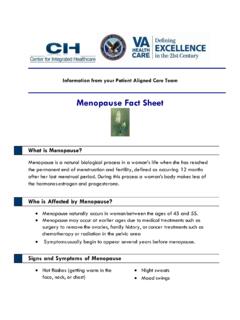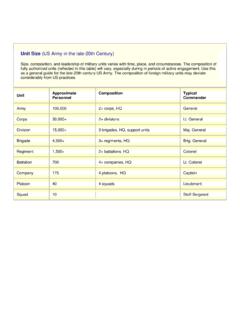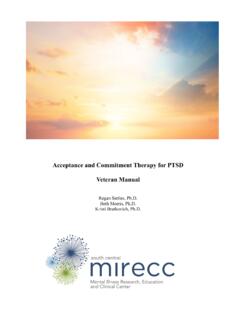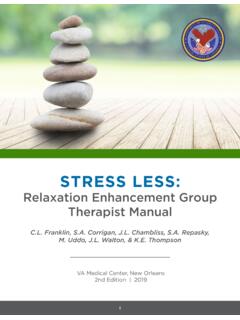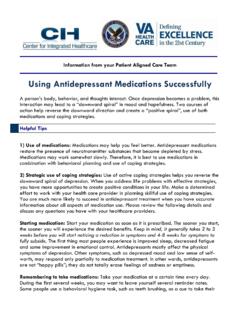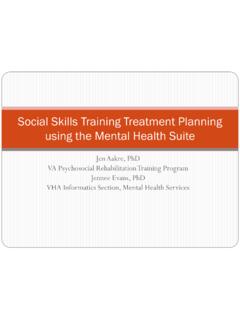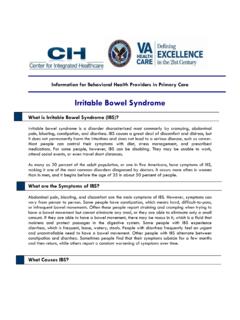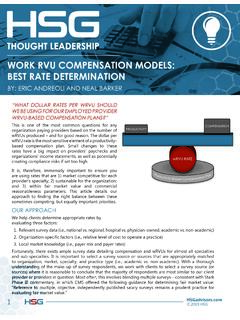Transcription of HEADACHE: Types, Tips & Treatment Suggestions
1 Information from your Patient Aligned Care Team headache : Types, Tips & Treatment Suggestions Headaches are one of the most common complaints patients present with in primary care settings. They are often correlated with stress, tension and a litany of existing medical conditions. Often, patients will live with headache pain for months or even years before seeking care. Over the counter remedies like aspirin, ibuprofen and acetaminophen are often used to reduce symptoms of pressure and pain prior to seeking medical advice. The following information is intended for patients that suffer from chronic headache pain and are looking for ways to better manage symptoms, increase function and improve quality of life. A headache is a headache is a headache ..Right? There are actually two main types of headache , primary and secondary, and can differ greatly in intensity, frequency and duration. Primary: headaches include, but are not limited to, tension-type and migraine headaches and are not caused by other underlying medical conditions.
2 Over 90% of headaches are considered primary. Secondary: headaches result from other medical conditions, such as infection or increased pressure in the skull due to tumor, disease, etc. These account for fewer than 10% of all headaches. Types of Headaches Tension-type Headaches Tension type headaches are the most common, affecting upwards of 75% of all headache sufferers. As many as 90% of adults have had tension-type headache These headaches are typically a steady ache rather than a throbbing one, and affect both sides of the head Distracting but usually not debilitating People can get tension-type (and migraine) headaches in response to stressful events or a hectic day These headaches may also be chronic, occurring as frequently as every day Migraine Headaches Less common than tension-type headaches, migraines affect approximately 25 to 30 million people in the United States and cause considerably more disability, lost work days and lost revenue.
3 As many as 6% of all men and up to 18% of all women (about 12% of the population as a whole). experience a migraine headache at some time headache : Types, Tips & Treatment Suggestions (continued). Roughly three out of four migraine sufferers are female Among the most distinguishing features is the potential disability accompanying the headache pain of a migraine Migraines are felt on one side of the head by about 60% of migraine sufferers, and the pain is typically throbbing in nature Nausea, with or without vomiting, as well as sensitivity to light and sound often accompanies migraines An aura --a group of telltale neurological symptoms--sometimes occurs before the head pain begins. Typically, an aura involves a disturbance in vision that may consist of brightly colored or blinking lights in a pattern that moves across the field of vision About one in five migraine sufferers experiences an aura Usually, migraine attacks are occasional, or sometimes as often as once or twice a week, but not daily headache Triggers Many things can cause a headache , thus it is important for you to become aware of the factors in your life that may contribute to your suffering, and, if possible, make changes to minimize the chances of continued suffering.
4 Some examples of factors that can cause headache are outlined below: Emotional Factors: Stress (work, home, family), depression, anxiety, frustration, let down, even positive excitement Dietary Factors: Alcohol, aspartame, cheese, chocolate, caffeine, monosodium glutamate (MSG), processed meats containing nitrates Physical Factors: Getting too much or too little sleep, too much physical exertion, injuries, skipping meals Environmental Factors: Glare from the sun or bright lights, changes in the weather, strong odors, smog Hormonal Events: Menstruation, oral contraceptives, hormone replacement therapies, menopause Treatment of Headaches There are a number of medications, such as muscle relaxants, analgesics ( , aspirin, percocet, fiorinol), or antihypertensives that can help with migraine and/or tension headaches. If you're reading this, chances are they're not working for you or you haven't tried all available treatments yet. Taking medication isn't the only thing you can do to alleviate your headache .
5 Research has shown that numerous other methods, or behaviors, are also very effective in treating and managing recurrent headaches. Here are some examples of what you can do to increase your control over your headaches. Become educated about your specific headache type, visit websites, such as: The american council for headache education ( ). The american headache Society ( ). Engage in relaxation exercises to decrease stress and tension: Deep breathing & cue controlled relaxation Progressive muscle relaxation Headaches July 2013 Page 3. headache : Types, Tips & Treatment Suggestions (continued). Relaxation by recall Biofeedback Cognitive-behavioral stress-management: Focuses on increasing your understanding of the role of cognitions (thoughts) in stress responses, and relationships between stress, coping, and headaches Anti-depressant medications: Prozac, Paxil, Zoloft Elavil, Pamelor, Tofranil Combination of behavioral and medication therapies: For example, engaging in relaxation exercises and taking Zoloft at the same time Optimizing Treatment To be better able to treat your headache , it is important to keep track of your triggers, symptoms and progress.
6 Filling out a headache diary gives you, and your medical and behavioral health doctor, an accurate picture of the frequency and severity of your headache experience. It also provides a way to identify patterns, such as the association with certain foods or specific situations. Why Use a headache Diary? 1. Triggers: you may become more aware of your specific triggers as you monitor your headaches. Keeping a headache diary will help you determine whether factors such as food, change in weather, and/or mood have any relationship to your headache pattern. Track progress: diaries are also an excellent way to track your progress in Treatment . The Center for Integrated healthcare gratefully acknowledges the contributions of the US Air Force in the preparation of all or part of this informational brochure. 1 Sources: The International headache Society, The american council for headache education , The american headache Society, WHMC Clinical Health Psychology Dept, Neurology, The Clinical Psychologist, Journal of Consulting and Clinical Psychology, Behavior Therapy.
7 Headaches July 2013 Page 4. headache : Types, Tips & Treatment Suggestions (continued). SEVERITY. 1 = mild DATE 2 = moderate TRIGGER/S RELIEF MEASURE/S DURATION. 3 = severe Headaches July 2013 Page 5.
